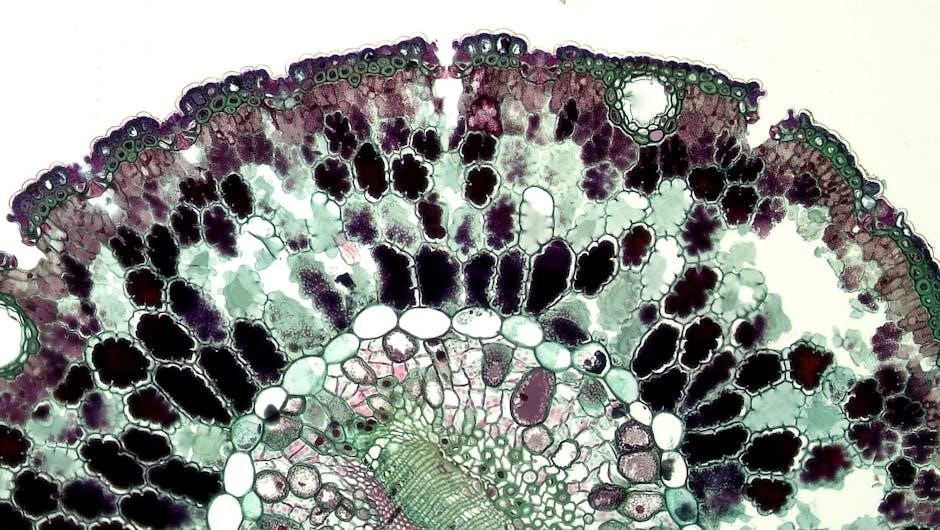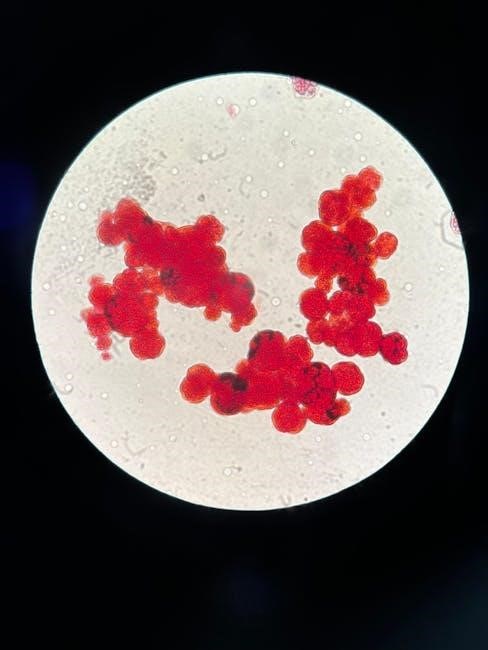Photosynthesis and cellular respiration are crucial processes studied in a comprehensive study guide using online resources and educational materials with detailed explanations and examples every day now online.
Importance of Photosynthesis
Photosynthesis is a vital process that supports life on Earth, and its importance cannot be overstated. The process of photosynthesis is essential for the survival of nearly all living organisms, as it provides the energy and organic compounds needed to sustain life. Through photosynthesis, plants, algae, and some bacteria convert light energy from the sun into chemical energy in the form of glucose, which is then used to fuel their metabolic processes. This energy is also passed on to other organisms through the food chain, making photosynthesis the ultimate source of energy for nearly all living things. The importance of photosynthesis is also evident in its role in regulating the Earth’s climate, as it helps to remove carbon dioxide from the atmosphere and produce oxygen, which is essential for respiration. Overall, the importance of photosynthesis is multifaceted and far-reaching, and it plays a critical role in maintaining the balance of life on Earth.
Basic Parts of the Chloroplast
The chloroplast is a complex organelle found in plant cells, and it is the site of photosynthesis. The basic parts of the chloroplast include the outer membrane, inner membrane, stroma, thylakoids, and lamellae. The outer membrane is a phospholipid bilayer that surrounds the chloroplast, while the inner membrane is a highly folded membrane that encloses the stroma. The stroma is the fluid-filled region of the chloroplast where the light-independent reactions of photosynthesis take place. The thylakoids are flattened sacs that contain the pigments and proteins necessary for light-dependent reactions. The lamellae are stacks of thylakoids that are connected by tubules, and they play a crucial role in the process of photosynthesis. Understanding the basic parts of the chloroplast is essential for understanding the process of photosynthesis, and it is a key concept in any photosynthesis and cellular respiration study guide. The structure and function of the chloroplast are highly specialized, and they allow plants to convert light energy into chemical energy.

Light Dependent Reactions
Light dependent reactions occur in thylakoids, converting light energy into ATP and NADPH using water and light energy every day now online with detailed explanations.
Energy Carriers ATP and NADPH
Energy carriers ATP and NADPH play a crucial role in the process of photosynthesis, storing energy from light and converting it into chemical energy.
This energy is then used to power the Calvin cycle, where carbon dioxide is fixed into organic molecules.
The production of ATP and NADPH occurs in the thylakoid membranes of chloroplasts, where light energy is absorbed by pigments and converted into chemical energy.
ATP is produced through the process of chemiosmosis, where protons are pumped across the thylakoid membrane, creating a proton gradient that drives the production of ATP.
NADPH is produced through the process of non-cyclic electron transport, where electrons are transferred from water to NADP+, resulting in the formation of NADPH.
The energy from ATP and NADPH is then used to drive the Calvin cycle, where carbon dioxide is fixed into glucose and other organic molecules.
Overall, the production of ATP and NADPH is essential for the process of photosynthesis, and their energy is used to power the conversion of light energy into chemical energy.
Gas Exchange and Stomata
Gas exchange is a critical process in photosynthesis, where carbon dioxide enters the leaf and oxygen is released into the atmosphere.
This process occurs through small openings on the surface of leaves called stomata, which are controlled by guard cells that regulate their opening and closing.
The stomata allow for the exchange of gases, including carbon dioxide, oxygen, and water vapor, and are typically found on the underside of leaves.
The opening and closing of stomata is controlled by the guard cells, which respond to changes in light, temperature, and humidity.
When the stomata are open, carbon dioxide enters the leaf and oxygen is released, allowing for photosynthesis to occur.
The gas exchange process is essential for photosynthesis, as it provides the necessary carbon dioxide for the Calvin cycle and removes excess oxygen.
Overall, the regulation of gas exchange through stomata is a critical aspect of photosynthesis, and is essential for the survival of plants.
Understanding gas exchange and stomata is important for understanding the process of photosynthesis and how it occurs in plants.

Cellular Respiration Process

Cellular respiration process occurs in cells using glucose and oxygen to produce energy with online study guides and educational resources available now every day for students online always.
Aerobic Cellular Respiration Reactants and Products
Aerobic cellular respiration is a process that occurs in the presence of oxygen, resulting in the production of energy for cells. The reactants of aerobic cellular respiration include glucose and oxygen, while the products include carbon dioxide, water, and energy in the form of ATP. This process is essential for the survival of most living organisms, as it provides the energy needed to perform various cellular functions. The equation for aerobic cellular respiration is: glucose + oxygen -> carbon dioxide + water + energy. Online study guides and educational resources are available to help students understand the reactants and products of aerobic cellular respiration, including diagrams, illustrations, and interactive tutorials. These resources can be used to support learning and teaching in classrooms, homes, and other educational settings. By understanding the reactants and products of aerobic cellular respiration, students can gain a deeper appreciation for the importance of this process in living organisms.
Relationship Between Photosynthesis and Respiration
The relationship between photosynthesis and respiration is a fundamental concept in biology, and is often explored in study guides and educational resources. Photosynthesis and respiration are two complementary processes that occur in living organisms, with photosynthesis producing glucose and oxygen, and respiration using glucose and oxygen to produce energy. The products of photosynthesis are the reactants of respiration, and vice versa, illustrating a cyclical relationship between the two processes. This relationship is essential for life on Earth, as it allows energy to be cycled between organisms and their environment. Online resources, such as diagrams and illustrations, can help students visualize and understand the relationship between photosynthesis and respiration. By studying this relationship, students can gain a deeper appreciation for the interconnectedness of living systems and the importance of these processes in supporting life. This understanding is crucial for understanding many biological concepts and principles.

Factors Affecting Photosynthesis Rate
Light intensity and temperature are key factors affecting photosynthesis rate daily online;
Temperature and Rate of Photosynthesis
Temperature plays a significant role in the rate of photosynthesis, with optimal temperatures varying between species. Generally, temperatures between 20-30 degrees Celsius are considered ideal for photosynthesis.
At higher temperatures, the rate of photosynthesis increases, but only up to a certain point, beyond which it decreases due to enzyme denaturation and other factors.
Conversely, at lower temperatures, the rate of photosynthesis decreases, as enzyme activity and membrane fluidity are reduced.
The relationship between temperature and photosynthesis rate is often studied in plant physiology, and understanding this relationship is crucial for optimizing crop growth and productivity in different environments.
Additionally, the effect of temperature on photosynthesis rate can be influenced by other factors, such as light intensity, water availability, and nutrient supply, making it a complex and multifaceted topic.
Overall, temperature is a critical factor affecting the rate of photosynthesis, and its optimal range can vary significantly between different plant species and environments.
Other Factors Influencing Photosynthesis Rate
Several other factors influence the rate of photosynthesis, including light intensity, water availability, and nutrient supply.
Light intensity is a critical factor, as it provides the energy required for photosynthesis to occur.
Water availability is also essential, as water is a reactant in the photosynthetic process.
Nutrient supply, particularly nitrogen, phosphorus, and potassium, is necessary for the synthesis of chlorophyll and other pigments.
Additionally, factors such as air pollution, soil pH, and salinity can also impact photosynthesis rate.
Understanding these factors is crucial for optimizing crop growth and productivity in different environments.
By recognizing the complex interactions between these factors, farmers and agricultural scientists can develop strategies to enhance photosynthesis and improve crop yields.
Overall, the rate of photosynthesis is influenced by a multitude of factors, and understanding these factors is essential for improving plant growth and productivity.
